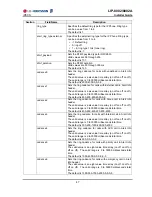
LIP-8002/8002A
iPECS
Installer
Guide
99
Appendix F. Auto Provisioning Routine
General
The LIP-8002/8002A incorporates software routines to automatically provision the configuration
and software of the phone. To initialize LAN settings, DHCP to gather basic network and
provisioning server information, downloads configuration and software files from the
provisioning server, and registers and subscribes with the SIP call server using the configuration
data.
The phone attempts contact with the provisioning server to download configuration files then
checks for software updates. For more details on the configuration files, see
Appendix D
. Note
downloads can be disabled separately for the configuration and software files. As a default, the
phone will employ TFTP as the download protocol. Optionally, the phone can employ
HTTP/HTTPS as the provisioning server protocol. If the DHCP server returns a URL for the
HTTP/S Option (default Opt. #160), the IP Phone shifts provisioning protocol to HTTP/HTTPS
using the URL provided to access the server.
DHCP
During the initial and subsequent boot-up cycles, the phone requests various data options from
the DHCP server. The following lists the requested options.
-
DHCP Option #1 Subnet Mask
-
DHCP Option #2 Time offset in seconds of the local time zone from GMT.
-
DHCP Option #3 Default Gateway (router) IP Address
-
DHCP Option #6 DNS Server IP Address
-
DHCP Option #42 SNTP Server IP Address
-
DHCP Option #50 IP address of the phone
-
DHCP Option #66 TFTP Server Name
-
DHCP Option #150 TFTP Server IP Address has priority over Option 66 when set.
-
DHCP Option #160 default HTTP/HTTPS URL for provisioning
TFTP Downloads
When TFTP is employed, the IP Phone will contact the server provided from the DHCP server
using the name or IP address from DHCP Option #66 or #150 or the TFTP server in memory
when the DHCP option is not available. The IP Phone will request the TFTP server send the
global configuration file (“sysconf_8002_sip.cfg”). Data from an unencrypted file is transferred
to the phone memory.
Changes in the provisioning data from the global configuration file are transferred to the phone
memory and the download process is repeated for the phone-specific configuration file.
Configuration data in the phone specific file overwrites data from the global file.
If a value is changed for a field marked with an asterisk in
Table D-1
, the reboot flag will be
enabled and the IP Phone will reboot after the download cycle is completed. By default, the
phone specific file uses the MAC address of the phone as the file name with no file extension.




































